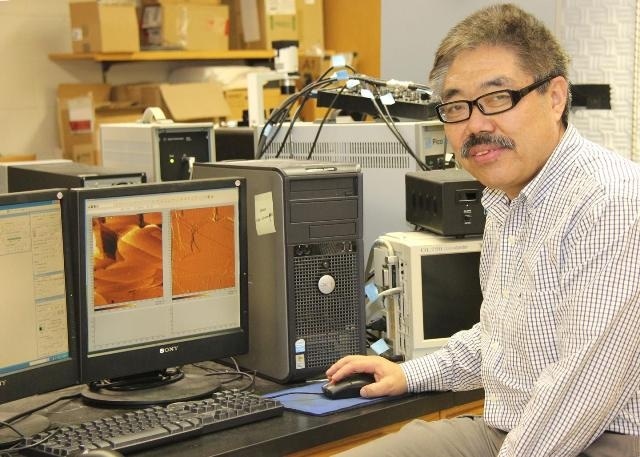Apr 5 2016
For the first time, researchers from the University of Georgia (UGA) and Ben-Gurion University in Israel have illustrated the possibility to develop nanoscale electronic components from single DNA molecules. This latest discovery, featured in Nature Chemistry, marks a major improvement in the quest to find a suitable replacement for the silicon chip.
 The University of Georgia's Bingqian Xu, along with his collaborators at Ben-Gurion University in Israel, used a single molecule of DNA to create the world's smallest diode. (Credit: Mike Wooten/University of Georgia)
The University of Georgia's Bingqian Xu, along with his collaborators at Ben-Gurion University in Israel, used a single molecule of DNA to create the world's smallest diode. (Credit: Mike Wooten/University of Georgia)
Bingqian Xu, lead author of the study, highlighted that this discovery may lead to the formation of improved electronic devices, which are extra strong and smaller in size.
For 50 years, we have been able to place more and more computing power onto smaller and smaller chips, but we are now pushing the physical limits of silicon. If silicon-based chips become much smaller, their performance will become unstable and unpredictable.
Bingqian Xu, Associate Professor, College of Engineering, UGA
Xu considered DNA to be a perfect solution to this challenge. He pointed out that DNA’s programmability, diversity, and predictability make it a key candidate to design functional electronic devices, utilizing single molecules.
In the paper published in Nature Chemistry, Xu and his team at Ben-Gurion University of the Negev explain how a single DNA molecule can be used to develop the world's smallest diode. Diodes play a significant role in electronic devices by allowing the flow of current in one direction and preventing the flow in another direction.
Xu and a group of graduate research assistants at UGA used a custom designed single duplex DNA of 11 base pairs and linked it to an electronic circuit measuring only a few nanometers. The team then inserted coralyne into the DNA after no special behavior was displayed by the measured current. The current flowing in the DNA was found to be 15 times more powerful for negative voltages than for the positive voltages, which is a significant characteristic of a diode.
This finding is quite counterintuitive because the molecular structure is still seemingly symmetrical after coralyne intercalation.
Bingqian Xu, Associate Professor, College of Engineering, UGA
Yanantan Dubi of Ben-Gurion University created a theoretical model, which highlighted the DNA’s diode-like behavior emerging from the bias voltage-induced breaking of spatial symmetry inside the DNA molecule, after inserting the coralyne.
Our discovery can lead to progress in the design and construction of nanoscale electronic elements that are at least 1,000 times smaller than current components.
Bingqian Xu, Associate Professor, College of Engineering, UGA
The team plan to continue their research as its aims to develop an increasing number of molecular devices and improve the functioning of the molecular diode.
The National Science Foundation extended its support to this research. The study, "Molecular rectifier composed of DNA with high rectification ratio enabled by intercalation," is also available online.